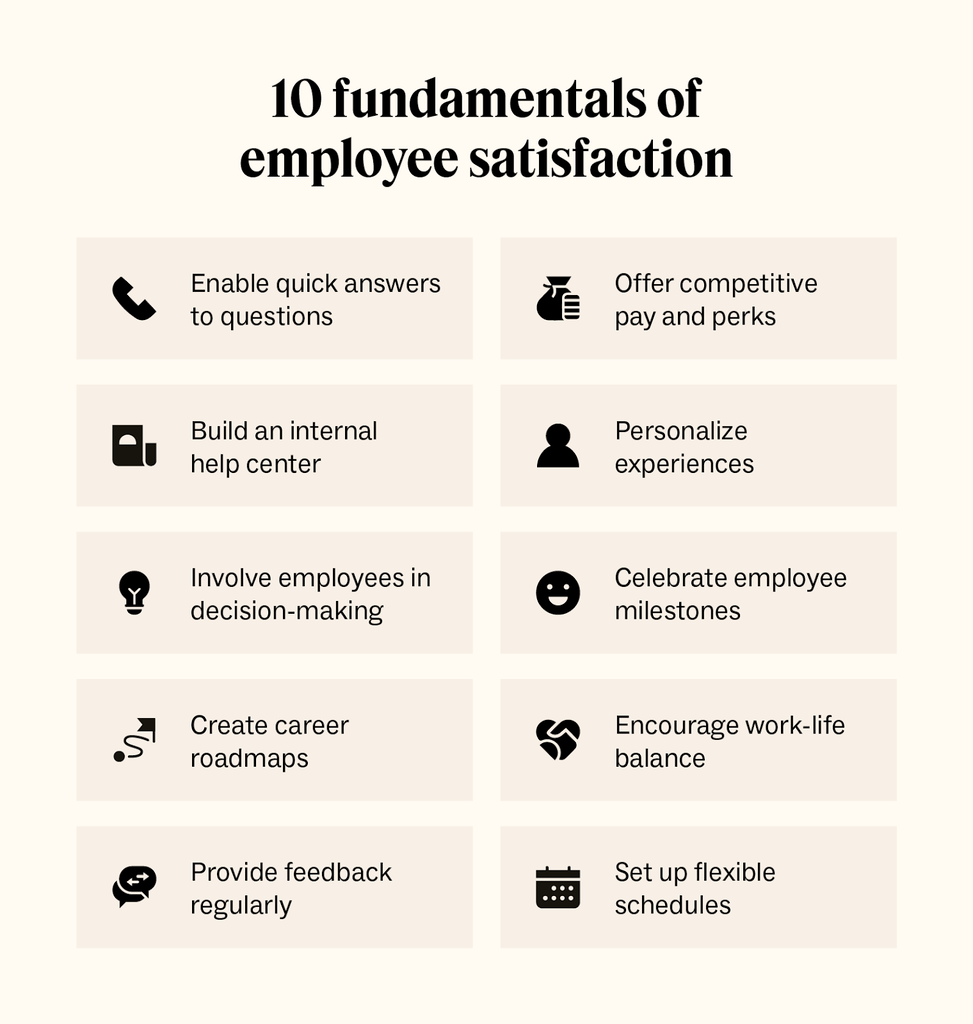
Employee satisfaction
Employee satisfaction is more than just happy workers. It’s the cornerstone of a successful and thriving business. Satisfied employees are more productive, more creative, and more likely to stay with your company. This translates to increased customer satisfaction, higher profits, and a stronger company culture.
What is Employee Satisfaction?
Employee satisfaction refers to how content and fulfilled employees feel about their jobs and the workplace environment. It encompasses various factors, including:
Job Satisfaction

Does the work itself provide a sense of purpose and meaning?
Work-Life Balance
Are employees able to maintain a healthy work-life balance?
Compensation and Benefits
Are employees fairly compensated for their work?
Company Culture

Is the company culture positive and supportive?
Communication and Recognition
Does the company maintain open and honest communication channels?
Leadership
Do employees trust and respect their leaders?
Why is Employee Satisfaction Important?
High employee satisfaction offers numerous benefits for businesses:
Increased Productivity
Happy employees are more productive employees. When employees are engaged and motivated, they are more likely to go the extra mile, work harder, and produce higher quality work.
Improved Customer Satisfaction
Satisfied employees are more likely to provide excellent customer service. They are more patient, more helpful, and more likely to go the extra mile to ensure customer satisfaction.
Reduced Turnover
When employees are happy, they are less likely to leave the company. High employee turnover can be costly and disruptive to business operations.
Enhanced Company Reputation
A company with high employee satisfaction is more likely to have a positive reputation in the job market. This can attract top talent and improve the company’s employer brand.
Increased Innovation and Creativity
When employees feel valued and respected, they are more likely to be creative and innovative. They are more willing to take risks, experiment with new ideas, and contribute to the company’s success.
Stronger Company Culture
High employee satisfaction fosters a positive and supportive company culture. This creates a more enjoyable and rewarding work environment for all employees.
How to Improve Employee Satisfaction
There are many things that companies can do to improve employee satisfaction:
Gather Employee Feedback
Regularly gather employee feedback through surveys, one-on-one meetings, and focus groups. This will help you identify areas for improvement and understand what matters most to your employees.
Offer Competitive Compensation and Benefits
Ensure that employees are fairly compensated for their work and offer competitive benefits packages. This will help attract and retain top talent.
Promote Work-Life Balance
Encourage a healthy work-life balance by offering flexible work arrangements, such as telecommuting and flextime.
Invest in Employee Development
Provide opportunities for employees to grow and develop their skills. This could include training programs, mentorship opportunities, and tuition reimbursement.
Recognize and Reward Employees
Recognize and reward employees for their hard work and contributions. This could include things like bonuses, promotions, and public recognition.
Foster Open Communication
Create an open and honest communication environment where employees feel comfortable sharing their ideas and concerns.
Build a Strong Company Culture
Foster a positive and supportive company culture where employees feel valued and respected. This could include team-building activities, social events, and volunteer opportunities.
Lead by Example
Leaders play a critical role in creating a positive work environment. Lead by example by demonstrating respect, empathy, and a commitment to employee well-being.
The Importance of Employee Recognition
Employee recognition is a crucial component of improving employee satisfaction. When employees feel appreciated and valued for their contributions, they are more likely to be motivated, engaged, and productive.
There are many ways to recognize and reward employees, such as:
Public Recognition
Recognize employees publicly for their achievements, such as at team meetings or company-wide events.
Private Recognition
Provide private recognition through handwritten notes, personalized emails, or small gifts.
Performance-Based Rewards
Offer performance-based rewards, such as bonuses, promotions, and paid time off.
Employee of the Month Programs
Implement an employee of the month program to recognize and reward outstanding employees.
Peer-to-Peer Recognition
Encourage peer-to-peer recognition by allowing employees to nominate and recognize their colleagues.
The Role of Technology in Improving Employee Satisfaction
Technology can play a significant role in improving employee satisfaction. For example, companies can use technology to:
Facilitate Communication
Use communication tools, such as instant messaging and video conferencing, to facilitate communication and collaboration among employees.
Automate Tasks
Automate repetitive tasks to free up employees’ time and allow them to focus on more strategic work.
Provide Access to Information
Provide employees with easy access to information and resources through company intranets and knowledge bases.
Track Employee Performance
Use performance management software to track employee performance and provide feedback.
Gather Employee Feedback
Use employee engagement surveys and other tools to gather employee feedback and identify areas for improvement.
The Impact of Remote Work on Employee Satisfaction
Remote work has become increasingly popular in recent years, and it can have a significant impact on employee satisfaction.
The Benefits of Remote Work:
Increased Flexibility: Remote work offers employees greater flexibility and control over their work schedules.
The Challenges of Remote Work:
Isolation: Remote work can lead to feelings of isolation and loneliness.
To ensure that remote work is successful, companies need to:
Invest in the Right Technology: Provide employees with the technology they need to be successful, such as high-speed internet, laptops, and video conferencing equipment.
Conclusion
Employee satisfaction is critical for the success of any business. By focusing on employee well-being, companies can create a more productive, engaged, and loyal workforce. This, in turn, will lead to increased profitability, improved customer satisfaction, and a stronger company culture.
By implementing strategies to improve employee satisfaction, such as gathering employee feedback, offering competitive compensation and benefits, promoting work-life balance, and recognizing and rewarding employees, companies can create a workplace where employees are happy, engaged, and motivated to succeed.